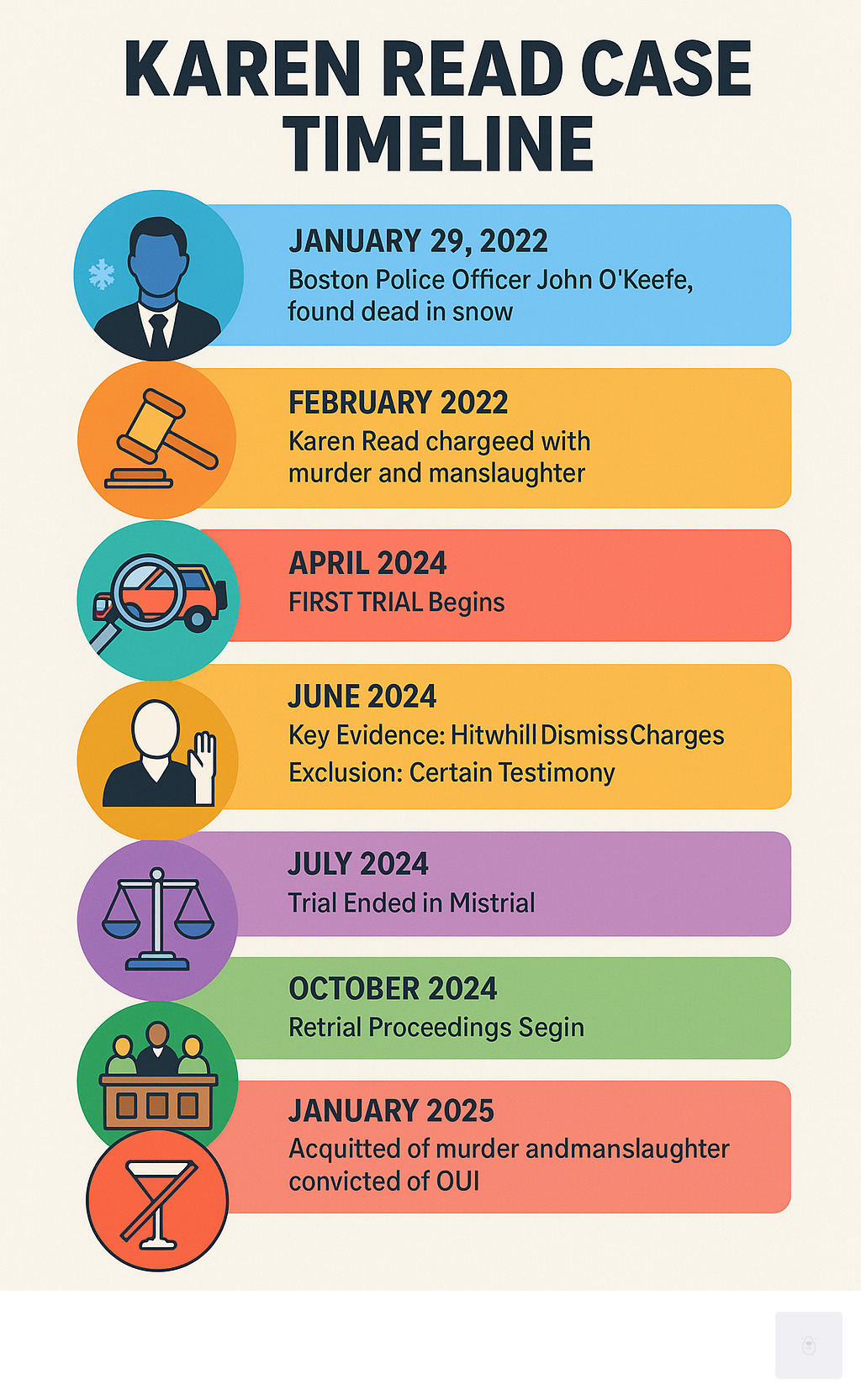
The High-Profile Case That Captivated Two Cities
Karen Read became a household name after being charged with the murder of her boyfriend, Boston Police Officer John O’Keefe, in a case that has gripped audiences from Boston to New York City. Here’s what you need to know:

Key Facts:
- Victim: Boston Police Officer John O’Keefe, found dead in snow on January 29, 2022
- Charges: Karen Read faced second-degree murder and manslaughter charges
- Final Verdict: Acquitted of murder/manslaughter, convicted of OUI (driving under influence)
- Cost to Taxpayers: Over $863,000 spent on retrial proceedings
- Current Status: Faces civil lawsuits and planning her own legal action
The case centers on whether Read struck O’Keefe with her SUV after a night of drinking, or if she was framed in an elaborate cover-up involving law enforcement. The defense claimed Read was innocent and that O’Keefe died in a fight inside a Canton home, with his body later moved outside.
After a mistrial in her first trial, Read was ultimately acquitted of the most serious charges but convicted of drunk driving. She received one year of probation and now faces a wrongful death lawsuit from O’Keefe’s family.
The case has drawn intense media scrutiny, spawning documentaries and generating a level of public interest in both Massachusetts and New York that we in the city have seen with other high-society scandals. The constant media coverage and public debate were truly remarkable. Costs exceeded $863,000 in taxpayer money for the retrial alone, including nearly $600,000 for forensic consultants and expert witnesses.
As R. Couri Hay, I’ve followed high-profile legal cases throughout my career in media and publicity, and the Karen Read case stands out for its combination of tragedy, controversy, and media fascination. Having covered society and legal stories for over four decades, I’ll guide you through the complex details that made this case a national obsession.

Karen read terms to remember:
The Case That Gripped the Nation: The Death of John O’Keefe
It was a bone-chilling morning on January 29, 2022, in Canton, Massachusetts, when everything changed. Boston Police Officer John O’Keefe was finded unresponsive in the snow outside a residential home, setting off a chain of events that would captivate audiences from Boston all the way to New York City.

The scene was immediately troubling. O’Keefe, a 16-year veteran of the Boston Police Department, lay motionless in the frigid New England weather. The autopsy would later reveal the devastating truth: he had died from blunt force trauma to the head combined with hypothermia from exposure to the brutal winter conditions.
As investigators pieced together the events of that tragic night, their attention quickly turned to O’Keefe’s girlfriend, Karen Read. The couple had been out drinking the evening before, and questions swirled about what happened in those final hours.
Within days of the findy, Karen Read was arrested and charged with serious crimes that would define the next two years of legal proceedings. The charges were severe: second-degree murder, manslaughter while operating under the influence, and leaving the scene of an accident resulting in death.
This wasn’t just another local crime story. The case had all the elements that make headlines stick: a police officer victim, a dramatic relationship gone wrong, and lingering questions about what really happened during those dark winter hours. From our perspective here in New York City, we’ve seen many high-profile cases capture the public’s attention, but the sheer ferocity of the debate and the division of public opinion in the Karen Read case was something to behold, maintaining an intense fascination that few stories can sustain.
The arrest marked the beginning of a legal saga that would divide public opinion, generate massive media coverage, and ultimately cost Massachusetts taxpayers hundreds of thousands of dollars. What seemed like a straightforward investigation would soon evolve into one of the most controversial criminal cases in recent memory.
A Tale of Two Trials: The Prosecution vs. The Karen Read Defense
The Karen Read case wasn’t just another court proceeding—it became a legal spectacle that captivated audiences from Boston all the way to our own New York City. The drama unfolded like a gripping novel, with two completely different stories being told about the same tragic night.
What made this case so compelling was how the prosecution and defense painted entirely opposite pictures of what happened to John O’Keefe. The intense public interest meant that every day brought new revelations, conflicting testimonies, and heated debates both inside and outside the courthouse. The complexity of the evidence and the explosive nature of the allegations ultimately required two separate trials to reach a resolution.
The Prosecution’s Argument: A Relationship’s Tragic End
The prosecution’s story was straightforward but devastating. They portrayed Karen Read as a woman whose relationship with John O’Keefe had turned toxic, culminating in a night of drinking and rage that ended in tragedy.

Their case centered on what they called overwhelming evidence. Read’s estimated blood alcohol content was dangerously high that night—well above the legal limit. They presented angry voicemails that Read had allegedly left for O’Keefe, painting a picture of a relationship in crisis.
The physical evidence seemed damning. Read’s SUV showed damage consistent with hitting a person, and investigators found fragments of her broken taillight at the scene where O’Keefe’s body was finded. Perhaps most compelling was the findy of O’Keefe’s DNA on Read’s vehicle.
The prosecution’s timeline was simple: after a night of heavy drinking and arguing, Read struck O’Keefe with her car and left him to die in the brutal cold. They carefully laid out their chronology of events, arguing this wasn’t premeditated murder but rather the tragic result of alcohol, anger, and fatally poor judgment.
The Defense’s Explosive Theory: A Cover-Up Involving Law Enforcement
Karen Read’s defense team took a dramatically different approach, presenting what can only be described as a bombshell theory. They didn’t just claim Read was innocent—they alleged she was the victim of an elaborate frame-up involving law enforcement.
The defense painted a picture of corruption and conspiracy. They argued that O’Keefe never died outside in the snow but was actually beaten inside Brian Albert’s home during some kind of altercation. According to their theory, his body was then moved outside to implicate Read.
The defense even suggested that a dog might have attacked O’Keefe inside the house, pointing to what they claimed were bite marks on his body. They argued that key evidence had been planted and that the investigation was hopelessly compromised from the start.
Central to their conspiracy theory was Trooper Michael Proctor, the lead investigator. The defense exposed shocking and deeply unprofessional text messages Proctor had sent about Read, including one where he wrote “hopefully she kills herself.” These messages were a bombshell in the courtroom and became a powerful rallying point for Read’s supporters, who saw them as undeniable proof of investigator bias and a compromised investigation from the very beginning.
The case gained additional momentum from independent bloggers and social media voices who championed the framing theory. The Free Karen Read website became a hub for supporters who believed in the cover-up narrative, adding another layer of public engagement to an already sensational case.
Key Evidence Under the Microscope in the Karen Read Trial
The heart of the Karen Read case came down to how each side interpreted the same pieces of evidence. What fascinated observers in New York City and beyond was how dramatically different the explanations could be for identical facts.
The taillight pieces found at the scene became a perfect example of this divide. The prosecution saw them as clear proof that Read’s SUV struck O’Keefe, while the defense argued they were planted evidence, part of the alleged frame-up.
Read’s Google search for “how long to die in cold” seemed damning to prosecutors, who viewed it as consciousness of guilt. The defense countered that it showed Read’s genuine concern and confusion about what had happened to her boyfriend.
Cell phone data told different stories depending on who was interpreting it. The prosecution used it to track Read’s movements and establish their timeline, while the defense argued it proved their client wasn’t where the prosecution claimed.
Perhaps most crucial was the testimony of Jennifer McCabe, whose account of that night became central to both sides’ arguments. The conflicting timelines and forensic analysis created a puzzle that even expert witnesses couldn’t definitively solve.
The dueling expert witnesses presented such different interpretations of the forensic evidence that observers were left wondering how the same facts could support such opposite conclusions. This complexity ultimately contributed to the case requiring multiple trials to reach a resolution.

